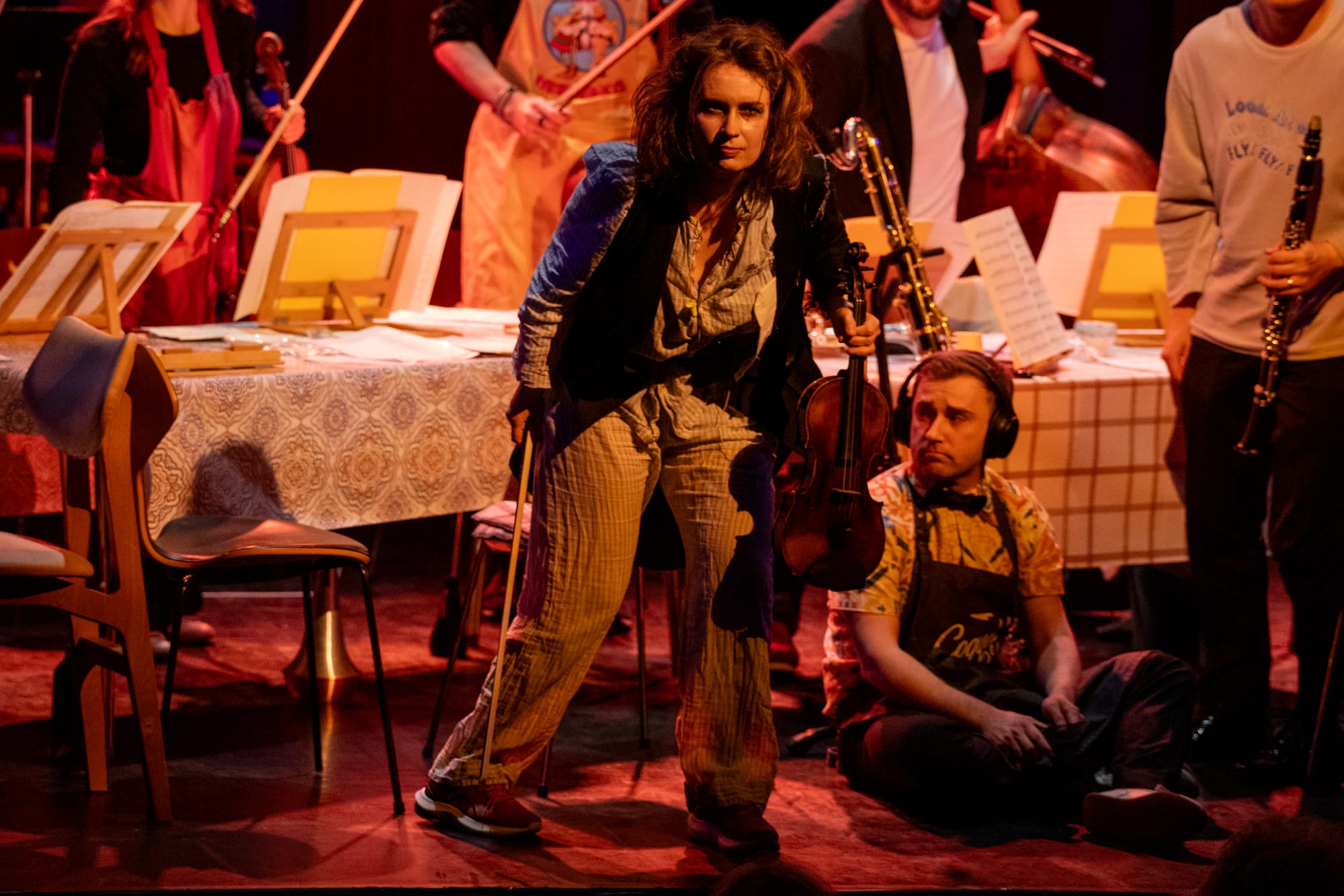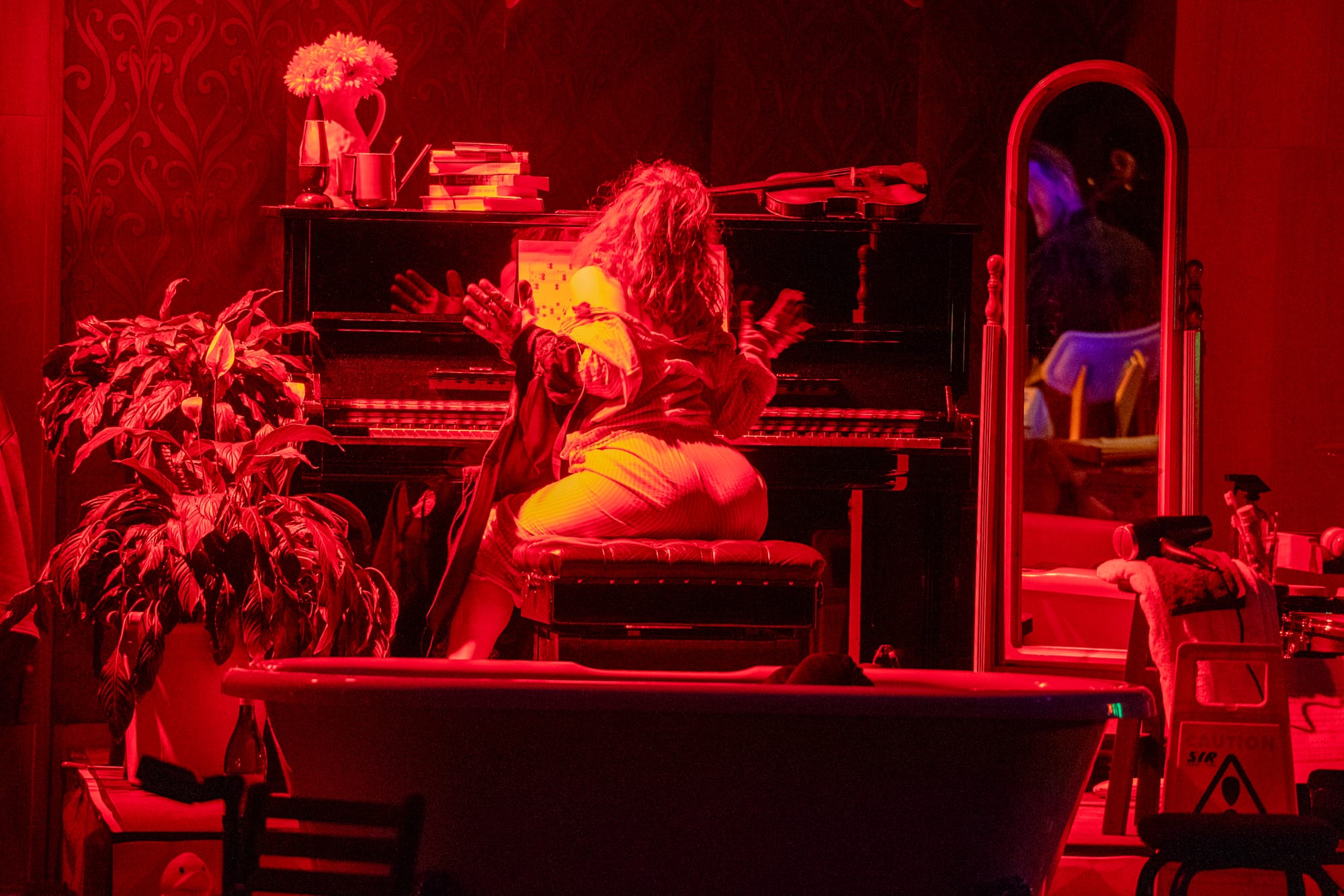Everyday Non-sense: Patricia Kopatchinskaja and Aurora's Southbank adventure
Fascinating, enriching, and unforgettable. But, frankly, you might just as easily hate it

Everyday Non-sense; works by Shiomi, Schmit, Higgins, Mozart, Kurtág, Cage, PatKop, Françaix and Ligei Patricia Kopatchinskaja (violin/voice/vacuum cleaner); members of Aurora Orchestra. Purcell Room at Queen Elizabeth Hall, Southbank Centre, London, 24.04.2024
The force of Nature that is Patricia Kopatchinskaja never does anything by halves, and here was an event guaranteed to split the critics. Paul Griffiths’ programme notes point out that President Woodrow Wilson would entertain at the White House by singing folk songs. I was he who said that ‘Music says nothing to the reason: it is a kind of closely structured nonsense.’ Which is pretty much what we got here: or perhaps it was loosely-structured given that while the pieces were listed, it was also announced that the order may differ in performance. Some were pretty easy to identify (Dick Higgins’ Danger Music Number Seventeen is a text score that consists of the word ’Scream' typed six times, each time followed by two exclamation marks: you can see it here); others, less so.
We were greeted by the performers already onstage as we, the audience, entered the auditorium. Here was an on-stage loving room like no other; the image/idea that repeatedly sprang to mind throughout the performance was Luis Bruñuel's 1962 film El ángel esterminador, on which Thomas Adès based his opera The Exterminating Angel (see my review of the UK premiere of that piece at the Royal Opera House, Covent Garden). Here was a space that was familiar yet not, shorn of its usual meaning via its presentation in a concert space, itself attempting to be a theatre, and wherein anything could – and often did – take place.
The inspiration for all of this is in fact Fluxus, a New York-based interdisciplinary group founded in the 1960s by George Maciunas. The group’s aim was to undermine and overturn the accepted in art; the substitution of words (text scores) for notes in music, for example. The text can ask the simple, but effective: Mieko Shiomi’s Falling Event refers to the distribution of programmes to the audience by throwing crumpled up balls of paper (the programmes) into the audience. Somewhat ironically, it turned out: a lady had only a few minutes before asked me where I got my programme from, to which I proudly replied, ‘I printed it out at home from the website’. So much for diligence ...
At the centre of the concert lay Mozart’s Ein musikalischer Spaß, K 522. It is difficult to play badly, deliberately, and Mozart puts definite challenges within, not least the French horn top Cs (there is a remarkable recording of this piece by Guido Cantelli and the Philharmonia Orchestra – the first horn was one Dennis Brain, and there is at least one biography that refers to his artistry in this piece!). Mozart’s japes were only evert going to be a launchpad, and indeed horn players left the stage after their crushing dissonances, only to return just in time to do it again; the music could morph at any moment. No horse jokes that I could see, though, for the finale (it was famously used as the theme tune to the BBC’s Horse of the Year Show - those of us of a certain age will remember it well – fading before the chaos sets in). The Mozart was performed one to a part on the strings, giving it a nice domestic feeling perfectly in tune with the pseudo-domesticity of the stage.
Here's that classic Cantelli performance of the Mozart, with the Philharmonia Orchestra:
Hammering – a nicely domestic sound – is found in Sanitas 151 (its title perhaps referring back to the pre-performance chores) by Tomas Schmitt. The instruction for this piece, Sanitas 151: Fluxversion 1 to give it its full title:(you can see it here), is simply that ‘all the piano keys of a chromatic scale are nailed down’. As with everything in this concert, it was done with energy aplenty.
George Brecht’s Symphony No. 3 subverts expectations by having the players slide to the floor. That’s it (although it does exist in various versions: click here for links to performances; none of them will take much of your time). Absurdist theatre at its finest, as is John Cage’s recontextualisation of the familiar in his Living Room Music, in which ‘any household objects or architectural elements may be used as instruments’ (the score goes on to give an example of one player using magazines, another the table, another ‘largish books’ and the fourth the ‘floor, wall, door or wooden frame of window’). There are words (‘Once upon a time the World was round,’ and so on). What was amazing was the energy the performers could gather in what is, effectively, a percussion piece.
Talking of energy brings us back to Kopatchinskaja the performer and her composing alter ego, PatKop. For the former, we had Kopatchinskaja the pianist in Kurtág's ‘Hommage à Tchaikovsky’ (from Játékok, Book 1). It consists, initially, of clusters, but unmistakably references the opening of Tchaikovsky’s First Piano Concero before veering off into a welter of glissandos. Kopatchinskaja clearly had a ball (all she needed was a Pierrot costume, really).

Intriguingly, Filippo Gorini has used this piece as an encore in a traditional symphony concert situation: this must have given the citizens of Liechtenstein something to chew on in the interval!:
It is by now de rigeur for Kopatchinskaja to include PatKop’s pieces in her concerts. Für Reto ... wo? was heard recently performed by herself and its dedicatee, Reto Bieri (review); here it was the Aurora Orchestra’s clarinettist in conversation; three other miniatures enlivened proceedings (Sonnerie for clarinet and violin, Friede sei mit Euch for violin, clarinet, percussion and police whistle, and Skizzenhaft - ‘Sketchy’).
In this context, it is perfectly in keeping with the Absurd to include some nice Jean Françaix: the 'Mouvement dfe valse' from his Octet, as French as can be. Here's a complete performance from Festival Mosaic of this delightful Octet:
How, then, to end, apart from the closing collapse in front of the audience? What better than a fanfare of car horns (from Ligeti’s Le Grand Macabre). There was more Ligeti, too: the Mysteries of the Macabre; a Barbara Hannigan calling-card (whether dressed in black leather - here in Gothenburg or, as with the LSO and Rattle in London, as a schoolgirl), and now one for Kopatchinskaja, perhaps. Vocal lines were negotiated superbly (with none of the operatic vibrato Hannigan sometimes brings); pure theatre.
It is refreshing to see his level of adventure, a reminder of the adventuring spirit of the 1960s and beyond where anything felt possible, and indeed of the concert life in London in the 1980s when, again, things were fresh and new. In a world that seems to be shrinking, Kopatchinskaja only expands horizons.
Fascinating, enriching, and unforgettable. But, frankly, you might just as easily hate it.
Photos © Pete Woodhead
